I have only one bike and, for the kind of riding I do, it’s not likely that I’ll buy another bike. Most of my rides are focused on just standard asphalt and gravel rides. With the bike I have, there’s really no need for me to have another bike. I mean, I could have one bike for road and another for gravel. But, one, I can’t afford it and, two, my wife would kill me if I got another bike. So...I have to make do with the bike I have.
One aspect of adding flexibility to my bike setup is by having a few wheelsets with different tire choices. I have three wheelsets total with a set of tires on each for a specific purpose. Which wheelset and tires I ride on largely depend on the kind of riding I’m doing as well as the conditions of the road. So, to illustrate this, I’m going to talk a bit about the evolution of the wheelsets I have, why I chose them, and what they’re good for.
Mavic Aksium Disc Wheelset with Continental Grand Prix 5000 Tires
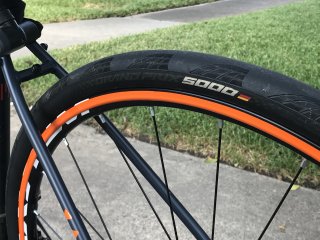
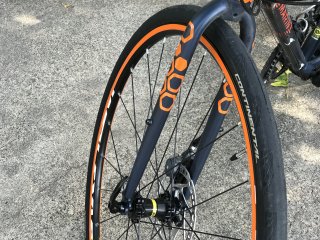
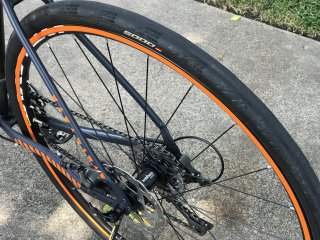
I just got this wheelset a few weeks prior to writing this post. In fact, it’s this wheelset that inspired me to write about the different wheelsets I have and how flexible multiple wheelsets can be.
When I first got my bike, it came with a generic 700c wheelset with a set of Schwalbe Spicer 700Cx30 tires on them. The Schwalbe Spicers are good tires and I still have them hanging in my garage as a spare set…but I figured I could improve my ride with a simple tire upgrade. As such, I opted to purchase a set of Continental Grand Prix 5000 road tires which, at the time, was just released. According to reviews, these offered better rolling resistance and puncture protection than most other road tires. I ended up getting the largest size available which is a 32mm version. Riding on the GP 5000’s was definitely an improvement. They definitely feel faster than the Spicer’s for sure.
The only problem I had early on was running too high of tire pressure. I was maxing out the back tire at 100psi with the front at around 90psi. The problem was that for a fresh, new set of slick road tires I probably should have run them at lower pressures first. Plus, you have to break in new road slicks before really getting down and dirty with them. Without breaking them in a bit, I think I set myself up for failure.
Just a few weeks or so into using these tires, I was on a bike trail and hit some wet muddy parts in the trail. It rained pretty heavily the day before and so there was quite a bit of tree moss and mud on the trail. Unbeknownst to me, the mud and moss caked onto the back tire causing it to slip out from under me on a turn. I landed on my side and slid a little ways. Fortunately I wasn’t going very fast but the spill did result in a little bit of road rash.
The two girls who happened to see me wreck looked at the blood on my arm and leg with one of them saying, “That looks really bad!” I glanced at my arm and then back at her and replied, “It looks worse than it actually is!” Yeah, it hurt but honestly my pride hurt more than anything.
The lesson here is that I really should have broke in the tires before venturing onto unknown territory. Lower tire pressures would have helped too. Plus, I probably should not have ridden on trails after a big rain. If I had stuck to mainly to dry asphalt and stayed off the trails then I probably would have been ok.
Regardless of this experience, me being totally inexperienced with road bikes at the time, I opted to find a tire with more tread (which I’ll go into more detail later with other wheelsets). In short, I basically switched to riding on a couple of different gravel-based tires on asphalt before switching back to a road slick.
After my crash, I didn’t feel confident in riding on road slicks. The Continental’s just made me nervous. So I hung up the default wheelset for a while. That is, until I rode a 57-mile road ride event (again, more on this later). While I was riding on a 700c wheelset, the tires I was using were not road slicks. I chose to ride on my 700c gravel wheelset which worked...but I could tell they slowed me down a little.
The experience of riding a gravel tire on a long distance asphalt ride pretty much told me that it would be a good idea to keep a 700c wheelset with the Continental tires on them. Prior to writing this post, a few weeks ago I tried to switch back to the stock wheelset but ended up borking the back hub. It completely locked up on me so...time to switch to a new wheelset! Fortunately for me, my local bike shop had a really nice Mavic Aksium Disc 700c wheelset on sale. Add a new cassette and rotors to the mix and I was back in business!
After riding on this wheelset with the GP 5000’s, I couldn’t be happier with this setup. The tires are now fully broken in and provide plenty of grip on the road. I can definitely tell a difference in the feel of the tire too. Breaking it in basically roughens up the tire and gives it more grip on the road. Plus, with the right tire pressure, they’re quite comfortable. As long as I stick to good asphalt and avoid muddy areas I’m fine.
Bottom-line is that if you’re riding predominantly on asphalt then stick with a good road tire. If you’re concerned about the lack of tread on a tire like the GP 5000, consider a road tire that offers a little more tread. Just don’t add too much tread. Hybrid tires can work but be very, very mindful that you don’t add too much tread. Otherwise, like me, you’ll learn that riding on an overly treaded tire can really slow you down a bit. On roads, the aim is the reduce the rolling resistance while still allowing solid grip on the road. As such, you really don’t need a whole lot of tread.
FSA NS 650b Wheelset with WTB Horizon Road Plus Tires
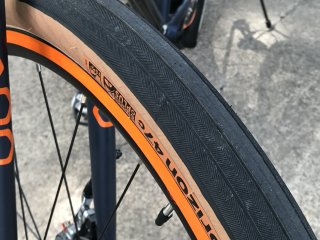
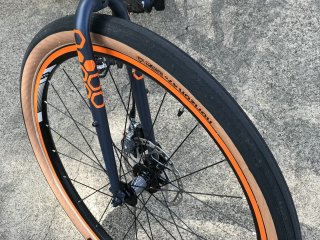
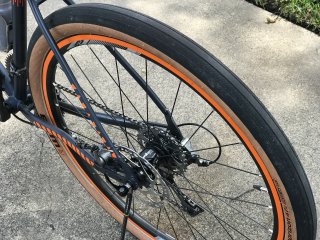
Like I mentioned above, after my little crash with the GP 5000’s, my confidence in road slick tires wasn’t good. At the time it happened, I was already starting to get interested in gravel riding. As such, I figured this would be a good time to find a new wheelset/tire combo that would more or less give me the best of both worlds.
The goal ultimately was to find the widest tire possible that could theoretically work for both road and gravel. My bike has a pretty good amount of clearance. With a 650b wheelset, I can go all the way up to a 47mm wide tire. So, yeah, pretty much a given I was gonna max it out! I was looking for some cush! :P
After a bit of research, I ended up getting a set of WTB Horizon Road Plus tires. The overall size of the tire makes them very close to the same circumference as a 700Cx30 tire. With a smooth centerline they ride a lot like a traditional road tire. The outer tread and channels add just enough grip for terrain that’s off the beaten path.
Along with that, because they’re tubeless compatible I definitely wanted to mount them to a tubeless ready wheelset to squeeze the absolute most cushiness I could get out of them. For that, I purchased a FSA NS 27.5” wheelset, which I found to be affordable and perfect for gravel applications. My local bike shop did the tubeless setup so I didn’t have to (so nice of them!).
Man, I was blown away when I rode on these for the first time! I found my cush for sure! They ride pretty well on asphalt but still slower than slicks. But where it really counts is on gravel. When running tubeless, you can ride at lower pressures which results in more tire surface hitting the ground. On gravel, this means more control over rougher terrain. I rode a 35-mile gravel ride on them and was totally satisfied with the performance.
And, holy shit, are these things light! I was shocked at just how light the tire/wheel combo was when I first picked them up. Even one of the guys at the bike shop was shocked when he picked one of them up. For an aluminum alloy set of wheels made for gravel and MTB, they’re surprisingly light. Even the tires themselves are pretty light so the combination really works to my advantage in reducing a little weight.
For most gravel rides, this is my go-to wheelset. Most of the gravel rides I’ve been on have fairly moderate terrain with little asphalt which is perfect for this wheelset.
This is also my go-to for recovery rides. The extra cushiness just makes for a more fun, relaxing ride. Plus, with the diameter being smaller than my other wheelsets, it doesn’t take as much energy to keep rolling. On a recent recovery ride I noticed that I can pedal softer, keep the bike moving, while maintaining a heart rate within the aerobic zone. This is something that I kind of struggle with on the other wheelsets.
However, there are some weaknesses. It’s a really wide tire and the diameter is like that of a 700Cx28 or 30 tire. So, yeah, they’re definitely not as fast as the Mavic/GP 5000 wheelset. Plus, there’s not a whole lot of tread. As such, for terrain like sand, mud, or really loose gravel things can get sluggish. For gravel rides where I might run into this kind of terrain, I would opt for a tire that had more tread. Which is where the next wheelset comes into play...
FSA NS 700c Wheelset with Specialized Pathfinder Pro Tires
After riding a while on the new 650b wheelset, I started thinking about what I could do to speed things up on asphalt. I rode a few group rides with the 650b wheelset and, while they worked, I kind of felt like I was struggling a bit to keep up. This was before I switched back to the Continental tires.
I was reading about how many gravel riders were choosing 700c wheelsets with 36-38mm wide tires. The larger diameter tires and wheels allow for greater speeds than what a 650b wheelset allows. Plus, with a bit smaller width tire there’s less tire on the road so you kind of have to throw some tread on it for gravel riding.
The goal for this set was similar to the 650b wheelset but with a slightly different focus. I wanted a tire that would do even better on asphalt than the WTB Horizon but still be capable of tackling virtually any gravel terrain. I wrote a review for the Specialized Pathfinder Pro 2Bliss Ready tires about a month ago. Because I was totally happy with the FSA NS wheels, I bought a 29” identical set and mounted the Pathfinder Pro to them.
Like I mentioned in my review, the Pathfinder Pro is a rather surprising tire. It basically does everything the WTB Horizon can do but better. Basically, it’s a faster tire than the Horizon. It’s just not as cushy as the Horizon. I found that I can run faster on just about everything. Even rides through sand and mud feel more stable. I felt like I was more in control over the bike on unstable terrain.
However, they still weren’t quite fast enough on asphalt. You would think that going from a 32mm to a 38mm tire would still be faster even with tread. Nope! They get the job done, sure, but the tread does tend to slow things down a little. Like I mentioned above, I rode on this wheelset for 57 miles on the Tour de Paris ride. It was a rather hot day and I could actually hear the tread unsticking from the ground as I rolled over tar on the road. That’s nuts! So, no, not great for an asphalt only ride like this.
So, what is this wheelset good for? Simple: speedy gravel rides! If I plan on going on a longer gravel ride I’ll likely want a wheelset that is faster with less rolling resistance. The 650b/Horizon wheelset is great but this one is just faster. If I know I’ll need some extra speed on a gravel ride, this will be the one I choose.
Summary of My Wheelsets
So, to breakdown my three wheelsets and what they’re good for, here’s what I have to choose from:
- 700c with 32mm road slicks: Great for road-only rides
- 650b with 47mm light gravel tires: Great for most gravel, recovery, and comfort rides
- 700c with 38mm gravel tires: Great for gravel rides when more speed is needed
Three wheelsets for one bike. With these combinations, I pretty much can go on virtually any kind of ride I want. All I need to know is a bit of information about the ride I’m going on: What conditions will I be riding in? How long will I be riding? How fast will I need to ride? The more I know about the ride I’m going on, the better.
Choosing the right wheels and tires can make all the difference in the world. The choices I made may not necessarily be the choices you’ll make. But hopefully by reading this you’ll come up with ideas of your own based on the kind of rides you’ve already been on or want to do.
Tires are perhaps one of the easiest upgrades you can make on a bike. The good news is that tires are relatively inexpensive. Grab a few wheelsets and try different things out. Read reviews of different tires and wheelsets. Talk to others about what they’re riding on. Based on all this information, just find what works for you. In the end, you’ll be so much happier with your ride. Mind those wheels and tires, boys and girls! :D
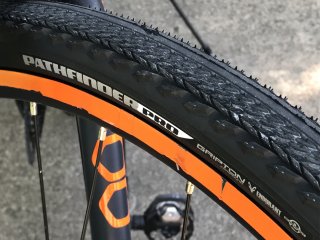
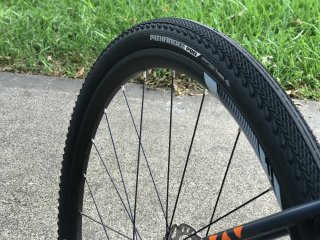
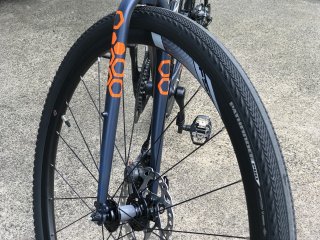
Post a comment!
Comments
Thanks for sharing! I have only one wheelset, 700x38 gravel, and although they get the job done on most surfaces, it can definitely be bumpy and slick on some trails. I'll check if my bike can do 45-47mm and give that a go.